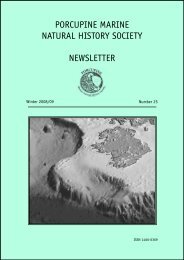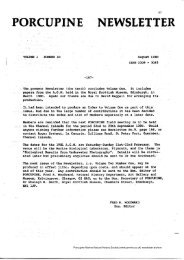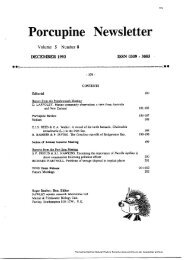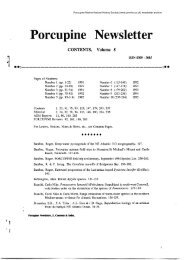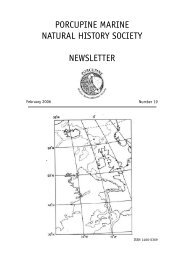PORCUPINE MARINE NATURAL HISTORY SOCIETY NEWSLETTER
PORCUPINE MARINE NATURAL HISTORY SOCIETY NEWSLETTER
PORCUPINE MARINE NATURAL HISTORY SOCIETY NEWSLETTER
You also want an ePaper? Increase the reach of your titles
YUMPU automatically turns print PDFs into web optimized ePapers that Google loves.
38<br />
Rathlin Island: A Sponge Biodiversity<br />
Hotspot?<br />
C.E. Goodwin and B.E. Picton<br />
Zoology Department, Ulster Museum,<br />
National Museums Northern Ireland, 153 Bangor<br />
Road, Cultra, Holywood, County Down, BT18 OEU<br />
claire.goodwin@gmail.com<br />
There have been few studies on British and Irish<br />
sponge biodiversity in recent years with the fauna<br />
of many areas last being studied by Bowerbank<br />
(1864,1866,1872,1874,1879), and in Ireland<br />
Stephens (1912, 1916, 1917, 1921). There are<br />
around 375 sponge species reported from UK and<br />
Irish waters but only about 100 of these are wellknown<br />
(Ackers, Moss & Picton, 1992; Howson &<br />
Picton, 1997). There are a few areas where better<br />
accounts of the sponge biodiversity are available,<br />
namely Plymouth (Burton, 1930,1957), Lundy<br />
(Hiscock, Stone & George, 1984), Lough Hyne<br />
(Van Soest & Weinberg, 1980) and Kilkieran Bay<br />
(Könnecker, 1973) but the sponge biodiversity of<br />
much of the British Isles, including Northern Ireland<br />
remains poorly known.<br />
Rathlin Island has been noted as being of particular<br />
biological importance with some 530 species of<br />
algae, marine invertebrates and fish recorded from<br />
here (60% of the marine species known from Northern<br />
Ireland), including many of particular interest (Erwin<br />
et al., 1990). It has been identified as one of the<br />
key areas for sponges in Europe (Van Soest, Picton<br />
& Morrow, 1999) and is designated as a Special<br />
Area of Conservation. Prior surveys by the Ulster<br />
Museum had shown it to have a particularly high<br />
sponge biodiversity and discovered several species<br />
not previously reported from the UK and other species<br />
which appear never to have been described in the<br />
scientific literature (Bernard Picton, pers. obs.).<br />
Specimens were collected by SCUBA diving<br />
around Rathlin Island, Northern Ireland. Specimens<br />
were selected by eye with the divers attempting<br />
to sample species that looked different from those<br />
previously sampled. The aim was to sample as many<br />
different species as possible, rather than gaining<br />
any quantitative information. Once selected, three<br />
photographs of each specimen were taken in situ<br />
using housed digital SLR cameras. A small piece<br />
(approx 1cm2 of tissue) was then removed. After<br />
collection the samples were kept in seawater<br />
for a few hours before being transferred to 95%<br />
Industrial Methylated Spirits for storage. Specimens<br />
were identified from tissue sections and spicule<br />
preparations (see Picton & Goodwin 2007a and 2007b<br />
for detailed methodology).<br />
PMNHS Newsletter No.24 Summer 2008<br />
In total 128 sponge species were recorded. A further<br />
6 species have been previously recorded from Rathlin<br />
but were not collected in this survey, bringing the<br />
total species known from Rathlin to 134. Of these,<br />
29 are previously undescribed species; 3 are new to<br />
Britain and Ireland (Plocamionida tylotata Brøndstedt<br />
1932, Myxilla (Styloptilon) ancoratum Cabioch 1968,<br />
Antho (Antho) brattegardi Van Soest and Stone 1986);<br />
9 are new to Northern Ireland (Axinella pyramidata<br />
Stephens 1916, Halicnemia patera Bowerbank,<br />
1862, Hymedesmia hibernica Stephens 1916,<br />
Hymedesmia peachii Bowerbank 1882, Hymedesmia<br />
primitiva Lundbeck 1910, Clathria (Microciona) laevis<br />
Bowerbank 1866, Raspailia aculeata (Bowerbank<br />
1866), Tricheurypon viride (Topsent, 1889), and<br />
Hexadella racovitzai Topsent, 1896). A further 19<br />
species require further investigation.<br />
Fourteen new species have been described so<br />
far: Axinella parva, Spongosorites calcicola, Crella<br />
plana, Phorbas punctata, Lissodendoryx (Ectyodoryx)<br />
jenjonesae, Antho (Antho) granditoxa, Hymeraphia<br />
breeni and Hymeraphia elongata (Picton & Goodwin<br />
2007a) and six new species of Hymedesmia (Goodwin<br />
and Picton in press). A paper describing Eurypon (9<br />
species) is currently in preparation. Records were<br />
also made of the poorly known species Axinella<br />
pyramidata, Myxilla (Styloptilon) ancoratum, Antho<br />
(Antho) brattegardi, Clathria (Microciona) laevis and<br />
Plocamionida tylotata (Picton & Goodwin 2007a).<br />
In total 134 sponge species are now known from<br />
Rathlin Island. This number represents approximately<br />
a third of the number of sponges currently known for<br />
the British Isles and is far greater than the number of<br />
species recorded in intensive surveys of the sponges<br />
of other areas. In comparable studies in Lough Hyne,<br />
County Cork, 90 species have been recorded (Lilly<br />
et al., 1953, Van Soest & Weinberg, 1980, Picton,<br />
1991), and a study of Kilkieran Bay on the west coast<br />
of Ireland (Könnecker, 1973) identified 66 species<br />
as being present in the area. This demonstrates<br />
that Rathlin Island is one of the most important<br />
sites in the British Isles, and probably in Europe, for<br />
sponges. In biogeographical terms the sponge fauna<br />
of Rathlin is interesting, combining both boreal<br />
and Mediterranean species. Populations of other<br />
invertebrate groups on Rathlin represent species at<br />
the limits of their range (for example the colonial<br />
anemones Parazoanthus axinellae, a southern species<br />
and Parazoanthus anguicomis, a northern species,<br />
co-exist here (Erwin et al., 1990). It is probably that<br />
this is also the case for some of the sponge species,<br />
studies of other areas in the British Isles would help<br />
put this into a biogeographical context.<br />
The number of new and rare species was unexpectedly<br />
large, although this is in part due to richness of the



